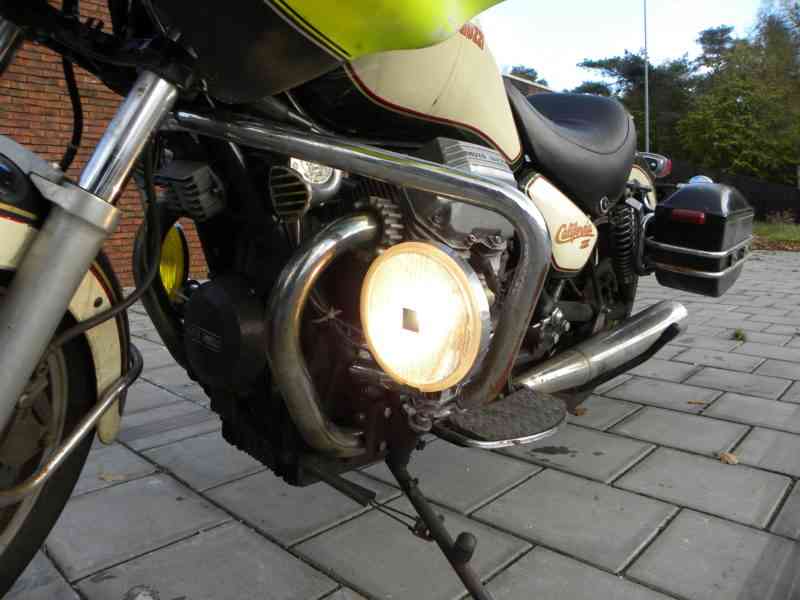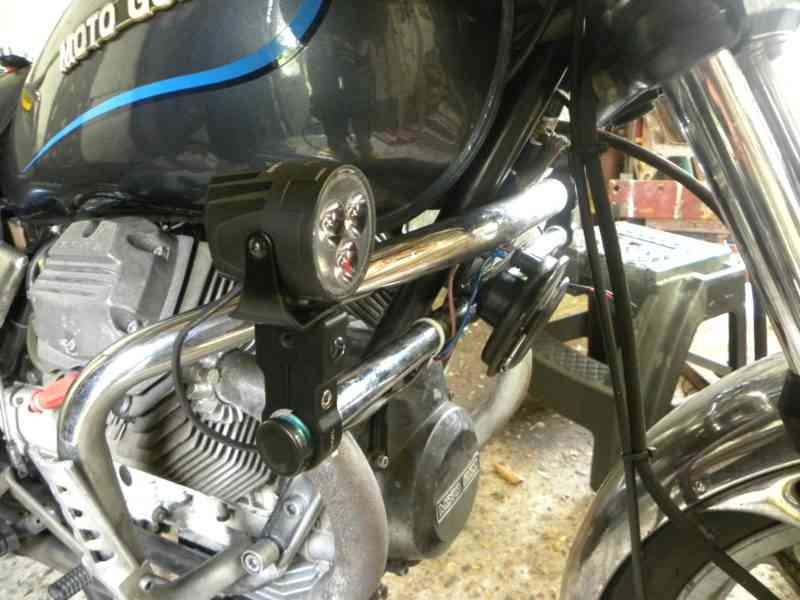Meanwhile, there is a whole generation of technicians who look glassy when they see contact points. A while ago, a Road Warden became almost emotional when he was allowed to help someone who had bad luck. That was pure nostalgia for him.
The classic owner had also forgotten a golden rule from the early days of his motorcycle: 'Never go out without a set of extra contact points and a capacitor'. But the problem was solved. The Road Guard took a selfie with the Triumph on the background.
The ignition system of a mixture engine is the system of battery, ignition coil, distributor, breaker and spark plugs, which ensures the combustion of the compressed gas mixture at the right time.
In the beginning
The fuel / air mixture engine was actually only possible because inventions and discoveries in the electrical field were also made in the same period, which would later become the battery ignition coil ignition system. In the dawn of the idea, of course, it was impossible to manually create a spark every time the piston was doing the compression stroke. But it has been tried. Fortunately, however, it turned out to be possible to convert the low voltage of a battery into a high voltage and thus allow a spark to jump between the electrodes of a spark plug and thus take care of the ignition.
In 1860, the Belgian Etienne Lenoir invented the spark plug with electric ignition, which is still very similar to what we today understand by the conventional battery ignition coil ignition. He integrated Heinrich Daniel Ruhmkorff's spark inductor, often referred to as Ruhmkorff inductor.
A good idea from Bosch
One of Robert Bosch's engineers invented the contemporary spark plug, combined with an ignition system. That plan was patented in 1902. Before that, glow plugs and even pieces of cloth were used to ignite the air / fuel mixture in a mixture engine. There are also a number of patents that have a similar system, but Bosch completed the system with the ignition coil in 1903.
The classic battery ignition coil
The parts of the classic ignition are: the breaker (the 'contact points'), the ignition coil, the capacitor, the distributor and the spark plug. In the classic country, electronic ignition sets are now more the rule than the exception. Not everyone agrees. Because:
- Electronic ignition is not original;
- Electronic ignition is not necessary for anything.
- The classic system with dots works great.
And there you have something. Especially with the mileage that we usually drive with our classics.
Yet
Electronic ignition also has its advantages To know:
- The system provides a much better spark, ignition and thus higher performance and therefore lower fuel consumption. That's somewhat theoretical. Usually a block starts better and can run better, nicer, with a correct ignition characteristic.
- There is less wear due to fewer moving mechanical parts. So the ignition remains 'on time'. You see little or nothing of it during installation. The originality concept therefore remains largely intact.
And those LED lamps?
A long story short: LED lighting is more effective with energy. LED lighting provides a lot of light, but 'consumes' much less power than the old-fashioned light bulbs. This economy can come in handy for classics with their limited electrical installations. You put less strain on the battery and the dynamo, while still keeping visibility fine. Our main concern is to be seen. Because many Brough Superior and Vincent HRD riders will no longer chase their machines at top speed through the night-time Vosges. You are therefore quite smart with LED lamps. And because nowadays there are 6- and 12 V LED lamps that you can easily plug into the regular fittings, you don't have to be ashamed of them in terms of originality. At Aldi, LED lamps cost twice nothing. And they are often pretty bad. In terms of quality, you will only find Chinese dredging at many online stores. While those Chinese really can.
Also read:
- Engine tuning. Correctly adjusted, but still running poorly
- Winter time, key time
- Spark plugs: top technology for small change
- 6 V, 12 V, halogen, LED lighting. And back?
- See and be seen - column
Just points, no point!
Not a very small nitrous oxide cartridge: the condenser with screw cap
Led lamps. Ugly but practical for a daily driver in the fall and winter.
But you hardly see any of that after mounting. And compared to a 6V incandescent bulb it gives a lot of light








Don't pin me down completely, but the prohibition of an 'LED bulb' in a standard lamp unit
I know applies to vehicles after 2007. In years before that it should be allowed.
For cars from 2007 and beyond, there is an obligation of automatic lamp height controls.
Whether the headlampwashing system (beautiful scrabble words seems to me, by the way) is mandatory, I don't know.
What is under scrutiny at the MOT, is the light image
is given with dipped beam. There should be a sufficiently sharp dividing line between dark at the top
and light must be present below. Furthermore, the tipping point for the roadside light ascending to the right is a point of attention. That point must be sufficiently to the right and must not depart earlier than the center of the light beam aligned with the direction of travel to the right at an angle of nominal 15 degrees. All in accordance with the requirements for low beam in accordance with the RDW
In my Golf V I put LED bulbs H7 for low and high beam. When asked, the APK told me what they thought of it. It was approval and the light image was sufficient. Not a word about any disability of the LED's. Main beam is exempt from these requirements. It just has to work.
With a total of 18600 lumens, I have a bomb of light in front. No one blinks at me for glare and I see perfectly with it. A must indeed.
For motorcycles, the light should normally only come from one lamp unit at a time, according to the information I have firsthand from the Police. So two of those handy and fine fog lights or spotlights on the crash bars at work, that shouldn't be allowed. Although nothing beats an excellent box light on the front of the vehicle.
As long as you don't blind anyone with it, the use just seems justifiable to me.
My old trusted Blauwtje ('82) has Xenon H4. Perfect light.
The R1150R contains Led H4. Good light too. No blinkers oncoming.
You have to pay attention to that. Either way, LED is a major improvement compared to 'Halo no light'. At least a factor of 3
It is a pity that with after market installation the CAN bus in the Golf V acutely sees such a lamp as wrong if you do not add a load resistor. Bye bye energy savings.
Which my link in a previous comment, I totally dived into it.
The short version:
- You get it through the APK is not equal to, “it is allowed”.
- Outdoor lighting without ECE approval is not allowed
- ECE approval is only on the expensive LED solutions, not on the cheap Ali lights
- “By design” you can get ECE approval on a LED lamp in a reflector that is not designed for this (including the LED H4 lights)
And then zoom in on “is not allowed” versus “you will get away with it”.
Because the APK only tests on a limited number of points of the underlying road traffic law, it is not (yet) a rejection as long as the light image is good.
However, it is not allowed by law and if you adhere to it, you can be fined for it.
Maybe good to mention: 95% of the LED lighting on offer is not allowed on public roads.
See https://www.oudevolvo.nl/blog/2018/02/18/legale-led-koplampen-op-volvo-amazon/ for everything ins and outs. In any case, all LED 'spheres' that you put in a normal reflector are not allowed. So the depicted LED light with H4 fitting is prohibited.
Hi. In the 80s I drove a BMW 320/4 for three years. During that period I had built up enough technical knowledge to be able to carry out the “normal” maintenance myself. Among other things, adjusting valves and, indeed, adjusting the contact points. I thought that was the icing on the cake and I only stopped when I was triple sure that they were in the right place. Of course followed by an end-judgment test drive. If you paid enough attention to it, you would also notice it in the engine run. Economy was not such an issue yet. Nice walk though. 🙂
See Kees' reaction, he is very satisfied with LED lighting and electronic ignition.
Yes I also have super spark plugs in it.
As far as Aldi is concerned, yes things are cheap, they last a little less but you can also buy two at a time even cheaper.
regards
If BOSCH was never personally held in high esteem, since the 70s they have done everything they can to stop the development of contactless electronic ignitions of other brands, especially at Van Veen during the development of the OCR1000 Wankel motorcycle, we knew that the BOSCH ignitions could no longer meet our requirements, an unpleasant tragedy took place in the background in that area, BOSCH launched an unsubscribe to electronics companies for the development of electronic ignitions for motor vehicles, one of the companies concerned was BJE Busch Jaeger Elektronica in NRW , these developed an electrical ignition based on Transistor and HKZ control unit in the short term, which could be controlled by 3 possible sensors, to be called with Reed, inductive and by means of the already present contact points, when the companies concerned could control their systems had put on the table BOSCH the purchase price of d The usual contact points for the car manufacturers drastically reduced, this kept BJE on its concept with high investment costs, which was bought by BOSCH and shortly afterwards put on the market with the word BOSCH on the control unit! For the OCR1000 we have used the HKZ unit directly from BJE together with the digital and maintenance-free control unit developed by Dr. Hartig Karlsruhe, which is still at the highest level! (see OCR1000 in the Kreidler Database) Those are the games of the market giants!
That is why they have grown and remained
What's wrong with mounting an electronic ignition? Installation fine, provided that it is reversible. No hassle with adjusting. Turn base plate with electronic ignition until LED goes out, your ignition is just right. Do not worry about it anymore.
My experience is that the engine starts faster and runs better. Likes that old oldtimer too.
Not authentic? Plowing the land using a tractor is also not authentic. With a team of horses is authentic and a much more beautiful sight. Who still does that? Somebody object?
Led then? Fine, provided no external changes. Are opponents only driving during the day? Have you ever driven in the polder at night without much or no street lighting? With a measly 6 volt 15 watt light in the headlight. Then it rains and you see very little. Do you think your oldtimer likes to end up in the ditch? You also want to get home safely. I'm not even going to talk about those crappy turn signals or that meager sound of your horn.
Yes, all my old-timer 2-wheelers have reversible electronic ignition. Even where LED is not visible, the incandescent lamp has made way for LED.
Do you know what's nice about that? I am very satisfied with it.
Just about really original. Are new tires, cables, spark plug, oil, etc. original?
No of course not. But they are necessary for your safety. Then put LED there too.
Noted!